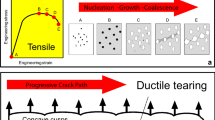Abstract
To accurately predict the occurrence of ductile fracture in metal forming processes, the Gurson-Tvergaard (GT) porous material model with optimized adjustment parameters is adopted to analyze the macroscopic stress-strain response, and a practical void nucleation law is proposed with a few material constants for engineering applications. Mechanical and metallographic analyses of uniaxial tension, torsion and upsetting experiments are performed. According to the character of the metal forming processes, the basic mechanisms of ductile fracture are divided into two modes: tension-type mode and shear-type mode. A unified fracture criterion is proposed for wide applicable range, and the comparison of experimental results with numerical analysis results confirms the validity of the newly proposed ductile fracture criterion based on the GT porous material model.
Similar content being viewed by others
References
Garrison J W M, Moody N R. Ductile Fracture [J]. J Phys Chem Solids, 1987, 48(11): 1035.
Jinkook K, Gao X S, Tirumalai S S. Modeling of Voids Growth in Ductile Solids: Effects of Stress Triaxiality and Initial Porosity [J]. Eng Fract Mech, 2004, 71: 379.
Gurson A L. Continuum of Ductile Rupture by Void Nucleation and Growth: Part I — Yield Criteria and Flow Rules for Porous Ductile Media [J]. J Engng Mater Technol, 1977, 99: 2.
Tvergaard V. On Localization in Ductile Materials Containing Spherical Voids [J]. Int J Frac, 1982, 18: 237.
McClintock F A. A Criterion for Ductile Fracture by Growth of Holes [J]. J Appl Mech, 1968, 35: 363.
Kobayashi S, Lee C H. Deformation Mechanics and Workability in Upsetting Solid Circular Cylinders [A]. in Proceedings of the North American Metalworking Research Conference [C]. Amherst: Dearborn, 1973. 185.
Wifi A S, Hamid A A, Abbasi N E. Computer-Aided Evaluation of Workability in Bulk Forming Processes [J]. J Mater Process Technol, 1998, 77: 285.
Reiner K, Gottfried B. The Determination of Formability for Cold and Hot Forming Conditions [J]. Steel Res, 1999, 70: 147.
Gouveia BPPA, Rodrigues J M C, Martins P A F. Ductile Fracture in Metalworking: Experimental and Theoretical Research [J]. J Mater Process Technol, 2000, 101: 52.
Rao A V, Ramakrishnan N, Kumar R K. A Comparative Evaluation of the Theoretical Failure Criteria for Workability in Cold Forging [J]. J Mater Process Technol, 2003, 142: 29.
Komori K. Proposal and Use of a Void Model for the Simulation of Ductile Fracture Behavior [J]. Acta Mater, 1999, 47 (10): 3069.
Oh S I, Chen C C, Kobayashi S. Ductile Fracture in Ax-Symmetric Extrusion and Drawing [J]. Transaction of the ASME, 1979, 101: 36.
Brozzo P, Deluca B, Rendina R. A New Method for the Predicting of Formability in Metal Sheet: Sheet Metal Forming and Formability [A]. Proceedings of the Seventh Biennial Conference of the International Deep Drawing Research Group [C]. Metals Park: Elsevier, 1972. 18.
Rice J R, Tracey D M. On the Ductile Enlargement of Voids in Triaxial Stress Fields [J]. J Mech Phys Solids, 1969, 17: 201.
Benzerga A A, Besson J, Pineau A. Coalescence-Controlled Anisotropic Ductile Fracture [J]. J Engng Mater Technol, 1999, 121: 221.
Gologanu M, Leblond J B, Perrin G, et al. Theoretical Models for Void Coalescence in Porous Ductile Solids. I. Coalescence “in Layers” [J]. Int J Solids Struct, 2001, 38: 5581.
Gologanu M, Leblond J B, Perrin G, et al. Theoretical Models for Void Coalescence in Porous Ductile Solids. II. Coalescence “in Columns” [J]. Int J Solids Struct, 2001, 38: 5581.
Pardoen T, Hutchinson J W. An Extended Model for Void Growth and Coalescence [J]. J Mech Phys Solids, 2000, 48: 2467.
Tang C Y, Lee T C, Rao B. An Experimental Study of Shear Damage Using In-Situ Single Shear Test [J]. Int J Damage Mech, 2002, 11: 336.
Faleskog J, Gao X, Shih C F. Cell Model for Nonlinear Fracture Analysis – I. Micromechanics Calibration [J]. Int J Fract, 1998. 89(4): 355.
Gao X, Faleskog J. Shih C F. Cell Model for Nonlinear Fracture Analysis — II. Fracture Process Calibration and Verification [J]. Int J Fract, 1998, 89(4): 375.
Moussy F H. Lefebure P. Critical Damage and Ductile Fracture: Quantitative Experimental Determination [A]. Predeleanu M. eds. Proc Int Symp on Computational Methods for Predicting Material Processing Defects [C]. Amsterdam: Elsevier, 1987. 275.
ZHAO Hui-juan, ZHUANG Zhuo, ZHENG Quan-shui. Test and Simulation for Large Deformed Torsion and Plastic Hardening [J]. Acta Mechanica Sinica, 2002, 34(5): 804.
Author information
Authors and Affiliations
Corresponding author
Additional information
Foundation Item: Item sponsored by National Natural Science Foundation of China (50575143); Research Fund for the Doctoral Program of Higher Education (20040248005)
Rights and permissions
About this article
Cite this article
Huang, Jk., Dong, Xh. A new ductile fracture criterion for various deformation conditions based on microvoid model. J. Iron Steel Res. Int. 16, 92–97 (2009). https://doi.org/10.1016/S1006-706X(10)60017-9
Revised:
Published:
Issue Date:
DOI: https://doi.org/10.1016/S1006-706X(10)60017-9




